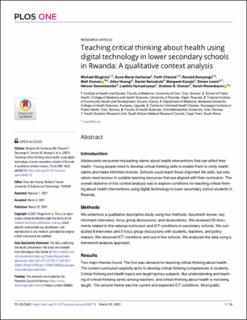Teaching critical thinking about health using digital technology in lower secondary schools in Rwanda: A qualitative context analysis
Mugisha, Michael; Uwitonze, Anne-Marie; Chesire, Faith; Senyonga, Ronald; Oxman, Matt; Nsangi, Allen; Semakula, Daniel; Kaseje, Margaret; Lewin, Simon Arnold; Sewankambo, Nelson; Nyirazinyoye, Laetitia; Oxman, Andrew David; Rosenbaum, Sarah Ellen
Peer reviewed, Journal article
Published version
Permanent lenke
https://hdl.handle.net/11250/2786976Utgivelsesdato
2021-03-22Metadata
Vis full innførselSamlinger
Sammendrag
Introduction: Adolescents encounter misleading claims about health interventions that can affect their health. Young people need to develop critical thinking skills to enable them to verify health claims and make informed choices. Schools could teach these important life skills, but educators need access to suitable learning resources that are aligned with their curriculum. The overall objective of this context analysis was to explore conditions for teaching critical thinking about health interventions using digital technology to lower secondary school students in Rwanda. Methods: We undertook a qualitative descriptive study using four methods: document review, key informant interviews, focus group discussions, and observations. We reviewed 29 documents related to the national curriculum and ICT conditions in secondary schools. We conducted 8 interviews and 5 focus group discussions with students, teachers, and policy makers. We observed ICT conditions and use in five schools. We analysed the data using a framework analysis approach. Results: Two major themes found. The first was demand for teaching critical thinking about health. The current curriculum explicitly aims to develop critical thinking competences in students. Critical thinking and health topics are taught across subjects. But understanding and teaching of critical thinking varies among teachers, and critical thinking about health is not being taught. The second theme was the current and expected ICT conditions. Most public schools have computers, projectors, and internet connectivity. However, use of ICT in teaching is limited, due in part to low computer to student ratios. Conclusions: There is a need for learning resources to develop critical thinking skills generally and critical thinking about health specifically. Such skills could be taught within the existing curriculum using available ICT technologies. Digital resources for teaching critical thinking about health should be designed so that they can be used flexibly across subjects and easily by teachers and students.

